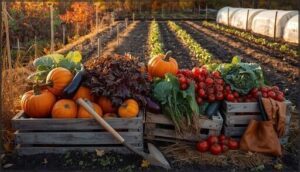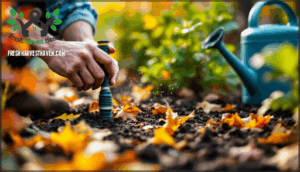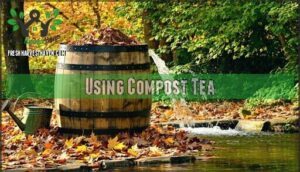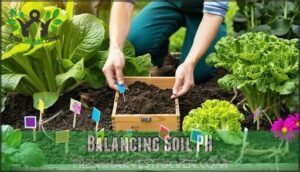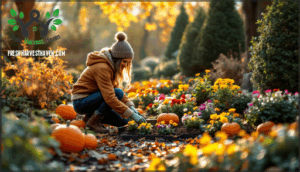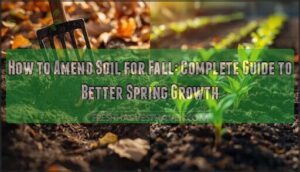This site is supported by our readers. We may earn a commission, at no cost to you, if you purchase through links.

Clean garden beds by removing spent plants, debris, and weeds to prevent disease carryover. Add compost or aged manure to enrich soil structure for next season.
Protect tender plants with cold frames or fabric covers as frost approaches. Store clean, oiled tools in dry locations to prevent rust.
The timing of these tasks can make or break your garden’s spring comeback. Ensure to follow these tips to maintain a healthy garden, and consider using fabric covers for additional protection.
Table Of Contents
- Key Takeaways
- Fall Garden Preparation
- Watering Tips
- Soil Enrichment
- Winterizing Gardens
- Fall Gardening Tasks
- Garden Pest Control
- Seasonal Garden Maintenance
- Frequently Asked Questions (FAQs)
- When should I stop watering my garden in the fall?
- How to take care of a garden in the fall?
- How do I winterize my garden in the fall?
- How do I enrich my garden soil in the fall?
- When should I stop fertilizing fall plants?
- How do I winterize garden irrigation systems?
- What vegetables can I plant in October?
- Should I rake leaves from flower beds?
- How do I protect bulbs from rodents?
- When should I harvest root vegetables?
- Conclusion
Key Takeaways
- Reduce watering to once weekly – Test soil moisture two inches deep with your finger before watering, since cooler fall temperatures mean slower evaporation and less water uptake
- Clean up garden beds thoroughly – Remove spent plants, debris, and weeds to prevent disease carryover, then add compost or aged manure to enrich soil for next season
- Protect tender plants from frost – Use cold frames or fabric covers when temperatures approach freezing, and monitor weather forecasts closely for sudden temperature drops
- Store tools properly for winter – Clean all garden equipment, oil metal surfaces to prevent rust, and store in dry locations to ensure they’re ready for spring use
Fall Garden Preparation
Fall preparation sets the foundation for your garden’s winter survival and spring success.
Smart gardeners know: autumn’s effort equals spring’s effortless abundance
Start by cleaning garden beds, removing spent plants, and composting fallen leaves to create nutrient-rich soil amendments that’ll pay dividends next growing season, which is a key part of winter survival.
Cleaning Up Garden Beds
Why wait until spring to tackle the mess winter will leave behind? Start your fall garden maintenance now with thorough garden cleanup.
Follow these essential debris removal steps:
- Clear fallen leaves, dead plant material, and accumulated summer debris from all beds
- Focus weed control efforts around perennials and shrubs before they establish deeper roots
- Practice bed sanitizing by cleaning tools with rubbing alcohol between different garden areas
- Edge beds for crisp boundaries and improved aesthetic appeal
- Gently loosen compacted soil with a garden fork to enhance air circulation
This systematic approach to garden cleanup tips prevents disease spread while preparing your beds for successful spring growth.
Effective garden maintenance also involves using the right tools, such as a garden rake tool, to make the process easier and more efficient.
Removing Dead Plants
Nobody wants their garden to become a disease breeding ground, so identifying dead plants early saves you headaches later.
Look for telltale signs like brown, wilted foliage and brittle stems that snap easily.
Using clean pruning shears, cut diseased plants at soil level for proper dead plant removal.
Skip the compost pile—toss these in regular trash instead.
Sanitize your tools with rubbing alcohol between each cut to prevent spreading plant disease throughout your fall garden cleanup routine.
Composting Leaves
Once you’ve cleared dead plants, transform that pile of fallen leaves into valuable soil amendments through effective leaf composting.
Garden recycling becomes simple when you understand proper composting methods.
Transform your yard waste into nutrient-rich fall mulch using these proven techniques:
- Hot composting – Mix brown leaves with green kitchen scraps, maintaining proper carbon-nitrogen ratios for rapid decomposition and heat generation
- Worm composting – Introduce red wiggler worms to chopped leaves, creating nutrient-dense vermicompost within 3-6 months
- Leaf mold creation – Stack whole leaves in wire bins, allowing slow natural breakdown to produce excellent soil moisture retention material
- Shredded leaf method – Run leaves through a mower or shredder first, dramatically reducing decomposition time from 18 months to 6 months
These leaf removal strategies turn autumn cleanup into spring garden gold, improving soil structure while reducing waste.
Watering Tips
Fall watering requires a shift from summer habits as cooler temperatures and increased rainfall change your garden’s moisture needs.
You’ll need to monitor soil conditions more carefully and adjust your irrigation schedule to prevent both drought stress and water-related diseases, which can be achieved by making a few key adjustments to your gardening routine, including being more mindful of watering.
Reducing Water Frequency
Your garden’s watering needs shift dramatically as fall arrives. Cooler temperatures mean slower evaporation rates and reduced plant water uptake, making water conservation easier while maintaining healthy soil moisture levels.
Fall’s cooler air means less thirsty plants—adjust your watering game accordingly
Most established plants need watering only once weekly, while drought-tolerant varieties can stretch to every 2-3 weeks. Understanding fall watering tips is essential for promoting healthy root growth and development.
Plant Type Fall Watering Schedule
Smart irrigation scheduling prevents overwatering while promoting drought resistance. Your fall garden watering routine should focus on deep, infrequent sessions that encourage strong root systems and improve moisture retention through winter.
Inspecting Soil Moisture
Two simple methods will tell you everything about your soil’s moisture levels.
First, perform the finger test by pushing your index finger two inches deep into the soil around your plants. If it feels dry at that depth, it’s time to water your fall garden.
For more precise soil moisture monitoring, consider these tools:
- Digital moisture meters provide instant readings without guesswork
- Soil testing kits reveal both moisture levels and soil density conditions
- Visual inspection of plant leaves shows early water stress signs
This soil moisture test approach helps you create an effective watering schedule fall gardens need for ideal health.
Avoiding Overwatering
Now that you understand how to check soil moisture, protecting your fall garden from overwatering becomes the next priority. Fall’s cooler temperatures reduce evaporation rates, making waterlogged soil a common problem that kills more plants than drought conditions.
Excessive moisture creates perfect breeding grounds for fungal diseases and root rot, turning your soil saturation into a plant graveyard. Your watering schedule fall should account for these slower drying conditions.
Watch for these overwater signs in your fall garden maintenance routine:
- Yellowing leaves that feel mushy rather than crisp when touched
- Fungal growth appearing as white or gray patches on soil surfaces
- Soggy soil that remains wet days after watering
- Root rot evidenced by blackened, soft roots when examined
- Increased pest activity thriving in overly moist environments
Check soil moisture two inches deep before watering again. Sandy soils drain faster than clay, requiring adjusted monitoring schedules. Proper mulching helps retain moisture naturally, reducing your watering frequency and preventing the feast-or-famine cycle that stresses plants during autumn’s unpredictable weather patterns.
Understanding summer garden watering techniques is essential for maintaining a healthy balance of moisture in your garden.
Soil Enrichment
Fall offers the perfect window to boost your soil’s health before winter dormancy sets in.
You’ll want to focus on three key areas: adding organic matter, brewing nutrient-rich compost tea, and testing your soil’s pH balance to guarantee favorable growing conditions come spring.
Adding Organic Matter
Rich organic matter transforms tired soil into a thriving foundation for next year’s garden success.
You’ll want to incorporate compost, aged manure, or worm castings to feed beneficial microorganisms while improving drainage and moisture retention.
Green manure from chopped cover crops works exceptionally well too.
Apply a two-inch layer of these soil amendments, then gently work into the top six inches without disturbing existing plant roots.
Effective soil improvement methods are essential for maintaining healthy and fertile soil.
Using Compost Tea
Why settle for basic fertilizers when compost tea delivers powerhouse nutrition straight to your plants’ roots? This liquid gold transforms your fall garden maintenance routine by brewing concentrated compost benefits into an easily absorbed organic fertilizer.
Tea brewing creates a microbe-rich solution that boosts soil fertility while supporting healthy microbe balance throughout your garden beds. You’ll discover this organic matter enhancement works perfectly alongside your composting leaves efforts.
Here’s your simple brewing process:
- Steep quality compost in water for 24-48 hours, stirring occasionally
- Strain the mixture through cheesecloth to remove solid particles
- Dilute the concentrate with water at a 1:10 ratio before applying
- Water plants thoroughly at soil level to maximize nutrient absorption
- Use immediately after brewing to maintain potency and effectiveness
Using compost tea bags can enhance the compost tea quality and overall soil health.
This soil enrichment technique delivers nutrients directly where plants need them most during fall preparation.
Balancing Soil PH
While compost tea feeds your plants, proper soil pH determines whether they can actually absorb those nutrients effectively.
Soil testing reveals your garden’s current pH levels and guides your fall fertilizer application strategy. Most vegetables perform best between 6.0-7.0, where nutrient uptake thrives naturally.
lime applications 2-3 months before planting
elemental sulfur or aluminum sulfate
Soil amendments work slowly, making fall the perfect time for soil preparation fall activities. Balanced nutrient balance guarantees your spring vegetables won’t struggle with locked-up minerals.
Winterizing Gardens
As winter approaches, you’ll need to take specific steps to protect your garden from frost damage and harsh weather conditions.
Proper winterizing involves mulching beds, covering tender plants, and safely storing equipment to guarantee your garden survives until spring’s return, which is crucial for its survival.
Protecting Plants From Frost
Protecting plants from frost becomes your garden’s lifeline when temperatures plummet below 32°F. Understanding your hardiness zone helps identify which species need immediate attention during cold snaps.
Your frost protection arsenal should include:
- Monitor weather forecasts religiously – frost often strikes when you least expect it, turning yesterday’s thriving garden into today’s casualties
- Water soil thoroughly before frost hits – moist ground retains heat better than bone-dry earth, creating a natural warming system
- Install cold frames or hoop tunnels – these simple structures can raise temperatures by up to 7°F, giving tender plants fighting chance
- Apply winter covers at sunset – fabric coverings trap radiant heat while preventing direct contact damage to delicate foliage
Cover vulnerable plants with frost cloths, sheets, or specialized plant insulation before temperatures drop. Remove coverings once morning temperatures rise to prevent overheating damage. Effective frost protection methods can make a significant difference in saving your plants from damage.
Mulching Garden Beds
Winter blankets aren’t just for people—your garden beds need them too.
Apply organic mulch like shredded leaves or wood chips in 2-4 inch layers around plants, keeping material away from stems to prevent rot.
This mulching strategy provides excellent moisture retention and weed suppression while regulating soil temperature during harsh weather.
Your fall garden maintenance routine isn’t complete without proper garden bedding preparation that protects plant roots and maintains soil moisture levels throughout winter.
Compost
Storing Garden Equipment
The end of gardening season signals it’s time for proper tool maintenance and equipment cleaning. Store your tools in dry locations to prevent rust and damage during harsh winter months.
Clean all garden equipment thoroughly before winterization, removing dirt and debris that can cause corrosion. Organize your storage space systematically for easy spring access. Oil metal surfaces and wrap hose reels to protect against moisture damage.
- Tool maintenance routine: Clean, oil, and inspect all equipment before storing in moisture-free environments
- Hose storage solutions: Drain water completely and coil hoses properly to prevent cracking and splitting
- Shed organization system: Group similar items together with clear labeling for efficient garden equipment storage
Properly storing garden equipment requires understanding of winter gardening tools to maintain their effectiveness.
Fall Gardening Tasks
Fall’s busy gardening schedule demands strategic action to prepare your landscape for winter’s arrival.
You’ll tackle three essential tasks: planting cool-season crops, dividing overcrowded perennials, and pruning trees and shrubs before dormancy sets in.
Planting Fall Crops
August through September offers prime crop selection opportunities for your fall garden maintenance.
Start seed starting for broccoli, kale, and Brussels sprouts in early August, counting backward from your first frost date for perfect harvest timing.
These fall planting choices actually sweeten after light freezes.
Focus on soil preparation by adding compost before seeding.
Extending growing season becomes effortless when you choose frost-tolerant varieties.
Late season harvesting rewards patient gardeners with exceptional flavor.
For optimal results, understanding fall seed options is essential for a successful fall garden.
Dividing Perennials
Most gardeners discover that dividing perennials transforms overcrowded clumps into thriving new plants. Fall provides ideal conditions for Plant Division since cooler temperatures reduce transplant shock while soil remains workable.
This Perennial Care technique involves separating root systems using sharp spades or garden forks for clean cuts. Each division needs viable roots and shoots for successful establishment. Root Pruning damaged sections guarantees healthy growth.
Proper spacing during replanting prevents future overcrowding. Garden Renewal through division creates multiple plants from one, expanding your garden economically.
Post-division watering establishes roots before plant dormancy begins, supporting robust Spring Preparation and enhanced blooming potential next season.
Pruning Trees and Shrubs
The secret to successful autumn garden care lies in strategic pruning trees and shrub care during dormancy.
Pruning tools should stay sharp and sanitized between cuts to prevent disease spread.
Here’s your essential tree trimming checklist:
- Remove dead, damaged, or diseased branches first
- Cut crossing limbs that rub against each other
- Thin overcrowded areas for better air circulation
- Shape shrubs by cutting back one-third of old growth
- Make clean cuts just above outward-facing buds
These cutting techniques promote vigorous spring growth.
Garden Pest Control
Fall pest activity doesn’t stop when temperatures drop—many insects actually become more active as they search for overwintering sites in your garden.
You’ll need to stay vigilant and adjust your pest management strategies to protect your plants through the changing season.
Managing Fall Pests
Fall pest management becomes your garden’s insurance policy against winter damage. These unwelcome visitors can destroy months of hard work if left unchecked.
Pest inspection reveals common autumn culprits that threaten your harvest:
- Aphids create sticky honeydew residue while clustering on cooling vegetables
- Cabbage loopers chew distinctive ragged holes through leafy greens and brassicas
- Cutworms sever tender seedling stems at soil level during nighttime raids
- Stink bugs pierce developing fruits, leaving dimpled and damaged produce
- Slugs multiply rapidly in moist conditions, targeting delicate fall crops
Aphid control and slug removal require daily monitoring during peak activity periods. Natural deterrents work best when applied early, preventing infestations before they establish overwintering sites in your garden beds. Effective fall garden maintenance involves understanding fall pest control strategies to protect your garden from damage.
Using Natural Pest Control
Nature offers powerful allies for pest control without harsh chemicals.
Biological control agents like ladybugs consume 5,000 aphids each, while natural repellents such as marigolds emit root chemicals suppressing nematodes.
Organic sprays using garlic reduce pest presence by 50%.
Pest traps and integrated management strategies protect plants from plant diseases and fungal diseases naturally.
Applying Insecticidal Soap
Your garden’s battle against soft-bodied pests becomes manageable with proper insecticidal soap application. This natural pest control method effectively targets aphids, spider mites, and other troublesome insects while maintaining garden safety standards.
Success depends on correct soap dilution and timing. Mix solutions at 1-2% concentration, testing on a small plant area first to avoid leaf damage. Apply during cooler morning or evening hours when temperatures won’t stress treated plants.
For ideal insect management:
- Spray both leaf surfaces thoroughly, focusing on pest-heavy areas
- Verify complete coverage without oversaturating delicate foliage
- Rinse plants gently after treatment to prevent soap residue buildup
- Reapply weekly as needed, monitoring for pest population changes
This approach prevents plant diseases while controlling harmful insects naturally, making it perfect for gardening enthusiasts seeking effective yet environmentally conscious pest control methods.
Seasonal Garden Maintenance
As autumn arrives, your garden’s needs shift dramatically, requiring you to monitor weather patterns and adjust your care routine accordingly.
You’ll need to balance reduced watering schedules with soil preparation tasks while planning ahead for a successful spring growing season.
Monitoring Weather Changes
Weather forecasts become your garden’s crystal ball during autumn months.
Check daily predictions because temperature fluctuations can drop 5-10°F overnight, catching plants off guard.
Rainfall patterns shift dramatically, reducing by 20-50% compared to summer.
Storm preparation matters as wind speeds above 20 mph boost evaporation rates.
Smart sensors and climate trends help you stay ahead of nature’s curveballs for effective frost protection.
Adjusting Garden Care Routines
Something shifts in every gardener’s approach when autumn arrives—it’s time to recalibrate your fall garden maintenance strategy.
Your garden scheduling transforms from summer’s intensive care to autumn’s measured rhythm. Reduce watering frequency as cooler temperatures slow evaporation and plant growth naturally decelerates.
Focus your seasonal planning on soil monitoring rather than aggressive feeding. Water conservation becomes effortless as nature provides more rainfall.
Start plant hardening by gradually reducing fertilizer applications, allowing your plants to prepare for winter’s dormancy phase.
Preparing for Spring Growth
Now’s the time to get serious about Spring Planning and Garden Renewal. Test your soil pH levels and organize seed packets while planning layout changes.
Planting fall bulbs sets you up for gorgeous spring blooms. Soil Prep with compost enriches beds during dormancy.
Your fall garden maintenance today determines next season’s success. Smart Growth Strategies and thoughtful Plant Selection transform winter prep into spring victories.
Frequently Asked Questions (FAQs)
When should I stop watering my garden in the fall?
Continue watering until the ground freezes, but reduce frequency as temperatures drop. Water trees and shrubs thoroughly after leaves fall, then shut off outdoor lines before freezing weather hits.
How to take care of a garden in the fall?
While your neighbors debate whether their gardens need life support, you’re smart to plan ahead. Clear dead plants, add compost, reduce watering frequency, and mulch around plants for winter protection.
How do I winterize my garden in the fall?
Clear debris, add compost, water deeply until ground freezes, prune dead branches, divide perennials, plant cover crops, mulch beds, and shut off outdoor water lines before frost hits.
How do I enrich my garden soil in the fall?
You’ll boost your garden’s foundation by adding 2-4 inches of compost, aged manure, or organic matter into the top six inches of soil.
Test pH levels and apply lime if needed for ideal nutrient absorption next spring.
When should I stop fertilizing fall plants?
Ease off the feeding spree by early September.
Your plants need time to harden off before winter’s chill arrives, so stop fertilizing six to eight weeks before your first expected frost.
How do I winterize garden irrigation systems?
Drain all water from pipes, sprinkler heads, and timers.
Shut off main water valves, then blow compressed air through lines to remove remaining moisture.
Store removable components indoors to prevent freeze damage.
What vegetables can I plant in October?
Plant garlic, onions, spinach, lettuce, radishes, and peas in October. These cool-season vegetables thrive in autumn’s cooler temperatures and will establish roots before winter, giving you fresh harvests through spring.
Should I rake leaves from flower beds?
You don’t need to rake all leaves from flower beds.
Remove diseased or pest-infested leaves, but leave healthy ones as natural mulch to retain moisture, suppress weeds, and enrich soil as they decompose naturally.
How do I protect bulbs from rodents?
Clever critter-control creates confident cultivation.
You’ll want to bury bulbs in wire mesh cages or hardware cloth baskets.
Sprinkle cayenne pepper or predator urine around planting areas to deter hungry squirrels and chipmunks effectively.
When should I harvest root vegetables?
You should harvest root vegetables when their tops start to yellow and die back, and the soil feels cool and loose.
Gently dig them up, brushing off dirt—don’t wait too long, or they’ll get woody.
Conclusion
Like autumn leaves dancing to winter’s rhythm, your garden’s evolution depends on thoughtful fall garden maintenance and watering tips.
You’ve learned to reduce watering frequency, enrich soil with organic matter, and protect plants from approaching frost.
These essential practices guarantee your garden sleeps peacefully through winter and awakens vigorously next spring.
Your attention to seasonal details now determines next year’s garden success, making these fall preparations truly worthwhile investments.

